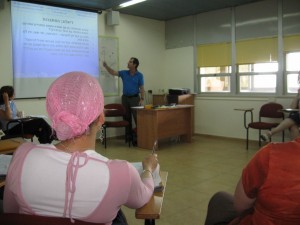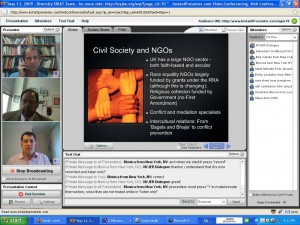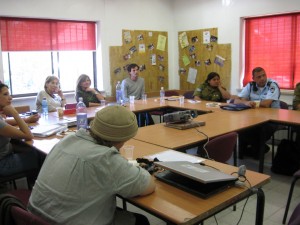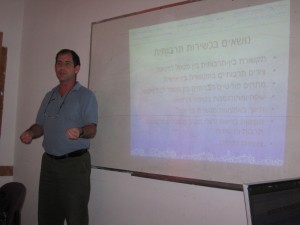A Call for Cultural Competency in Jerusalem’s Medical Services – an Article
We just published an article at the Jerusalem Post and Search for Common Ground (SFCG) News service on our cultural competency program in Jerusalem. Here are the links and the text:
SFCG: English, Arabic, Hebrew.
Text:
A call for cultural competency in Jerusalem’s medical services
HAGAI AGMON-SNIR , THE JERUSALEM POST
A few years ago, my mother underwent hip replacement surgery. Before she was discharged, the surgeon gave her quite a few instructions for the period following surgery. There were some necessary accessories and equipment: a wheelchair, special pillows and devices to help lift objects. These were available for almost nothing from Yad Sarah, an organization founded by haredim that lends medical equipment to those who need it.
“If you don’t follow the directions I gave you and you don’t use the equipment,” said the surgeon, “your leg won’t function the way it’s supposed to and the effects of the excellent and expensive surgery will be wasted.” Today my mother traverses the country with her new hip and any memory of the fracture has been erased.
Lying next to my Jewish mother in the hospital were Palestinian mothers from east Jerusalem who had also fractured their hips and received hip replacement surgeries. Most of them, like my mother, were covered by national health insurance, which made them luckier than their sisters from the West Bank and Gaza who are not entitled to these benefits. The women from east Jerusalem were given the same instructions my mother received and were also sent to Yad Sarah, which has branches serving east Jerusalem for the Palestinian population.
Yet there is good reason to suspect that, unlike my mother, many of them are limping today. Research carried out in hospitals in Jerusalem shows that about half of the Arabic-speaking patients do not understand the instructions they are given for post-treatment care because they are given in Hebrew.
One third of Jerusalem’s residents are Arabic-speaking Palestinians, both Muslim and Christian. In times of need, these residents will almost always choose to go to hospitals in west Jerusalem. At some of these medical institutions, more than half of the patients are Palestinian, yet none of them are provided translation services into Arabic or any other language. Occasionally, medical staff improvise and ask an Arab hospital worker or a visitor who speaks both Hebrew and Arabic to translate, making them privy to the patient’s personal medical details. It’s not unheard of for the patient’s child to act as a translator, telling his or her mother that the doctor recommends an abortion or that a suspicious lump was found in her breast.
In addition to the lack of language services, none of these establishments provide religious services to Muslims or Christians. Nurses complain about Muslim men washing their feet in sinks designated for hand washing. The simple solution – low sinks for feet-washing before prayers – cannot be found at any of these places. On the other hand, Jews may receive visits from a rabbi, have meals provided by various religious organizations according to their specific kashrut needs, or pray in an in-hospital synagogue.
RECENTLY, THE Jerusalem Intercultural Center hosted senior directors from the Coney Island Hospital in New York City, introduced to us through our collaborative work with Rabbi Bob Kaplan of CAUSE-NY, an organization committed to the availability of health services in New York. In compliance with the law, signs at the hospital appear in five languages, and anyone entering the hospital is entitled to receive hospital services in his or her own language. Sometimes a translator is present in the room and other times (with more obscure languages) translation is provided through a phone service, called tele-interpretation.
The hospital has a synagogue, a Christian church, a mosque and a Hindu temple – in accordance with the needs of the communities that it serves. Kosher food is provided for Jews and halal food for Muslims. In the case of Indians and Pakistanis, the food is prepared and spiced in a way that is suitable for their palate.
Is this hospital anomalous? Not at all. In the past 15 years the “cultural competency” approach has become widely practiced in health systems in North America, Australia and Europe. It has simply skipped over Israel, despite much evidence showing that medical services adjusted to culture, religion and language improve the quality of care and the outcome of treatment. And, of course, such an approach is far more just and ethical.
Shocked by this state of affairs, the Jerusalem Intercultural Center and the Jerusalem Foundation have launched an initiative to encourage cultural competency. The need, by the way, exists not only for the Palestinian population in the city, but also for the Yiddish-speaking haredi community (which comprises about one quarter of the city’s residents), as well as people from a variety of other backgrounds who speak languages like Amharic, Russian, French and Spanish. We are only at the beginning of the road, but already there are medical institutions, such as Alyn hospital (for pediatric rehabilitation) and Clalit Health Services, that are now building up cultural competency in their facilities.
We hope that by introducing cultural competency into the medical services in Jerusalem we will help reduce the current inequality that exists in this field. Moreover, we believe that this is a way to teach the people of this city the value of accepting the other, being considerate of those who are different from us and to encourage people to think in terms of human rights even in a city as fraught with tensions as Jerusalem.
The writer is the director of the Jerusalem Intercultural Center and can be reached at hagai@jicc.org.il. The project Cultural Competency in Jerusalem is sponsored by the Jerusalem Foundation. This article was written for the Common Ground News Service in collaboration with The Jerusalem Post.





